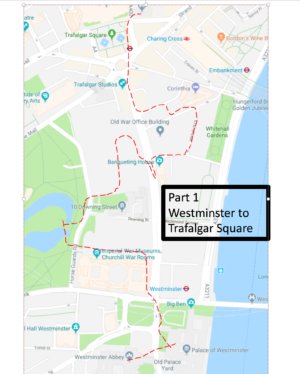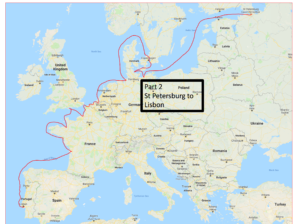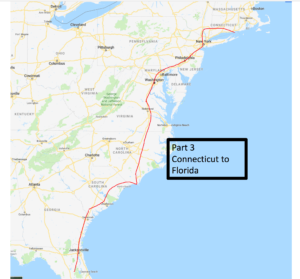I now have an ulterior purpose in this blog. I’m considering writing a book on “the history of explosive devices” and doing so in a perhaps unusual way. I propose to write the book in three parts, each part describing a geographic journey. I have probably 70% of the research done and readers of this blog will recognise parts of the content.
Part 1 describes a walk of perhaps a mile and a half. The walk starts at Westminster Abbey in London and finishes in a church just up the road in Trafalgar Square. This journey highlights the fact that explosive devices have targeted the centre of government and power over a 500 year period, and also highlights early bomb squad responses.
Part 2 describes a sea journey along the coast of Europe, beginning in St Petersburg and ending in Lisbon, Portugal. It highlights how war and revolution has driven the development of explosive device design and tactics.
Part 3 is a car journey in the United States, starting in Connecticut and ending in Florida, highlighting the surprising thread of explosive device use throughout the history of the USA.
On each case a short chapter will detail the events on the route with a map to provide the theme of a geographical context. I welcome your comments as to whether you might find this interesting or not and of course any incidents on these journeys I have omitted.
Part 1 – A walk from Westminster to Trafalgar Square
This section of the book describes a walk past the sites of various historic incidents and significant places in the history of explosive devices, showing how perceived or actual centres of power have often been the target of explosive devices. In summary the walk goes like this:
- Westminster Abbey. Suffragette Bomb, 1914
- The Houses of Parliament discussing the following attacks The Gunpowder Plot, Guy Fawkes et al 1605 Fenian Bombs in Westminster Hall and the House of Commons, 1885 Westminster Hall IRA Bomb, 1974 Westminster Palace Yard, assassination of Airey Neave with under car boobytrap, 1979
- Whitehall, Fenian bombing 1883
- Duck Island Bomb Disposal facility, St James’s Park , established 1894.
- Downing street, IRA Mortar attack 1991
- Admiralty Building off Horse Guards Parade Square, a peculiar bomb at the same time as Fenian attacks but probably different perpetrators. 1885
- Palace of Whitehall, Bomb attack attempt to assassinate Oliver Cromwell (device defused), possibly inspired by the Royalist Prince Rupert 1657
- Adjacent to Old War Office Building – launch site of the IRA mortar attack on Downing St. 1991
- Old Scotland Yard Police headquarters, Fenian Bomb attack 1884
- Nelson’s Column. IED consisting of 16 sticks of dynamite defused, 1884
- Church of St Martin in the Fields, Suffragette bomb attack 1914
Themes – repetition of attack targets, security measures, Church, State and the Law as targets. Characters discussed Col Majendie, Dr DuPre, Prince Rupert.

Part 2 – A sea voyage from St Petersburg to Lisbon along the Northern European coastline.
This journey highlights how war and revolution has inspired the development of explosive devices
- St Petersburg. The assassination of the Tsar by suicide bomb, perpetrated by Russian revolutionaries Narodnaya Volya 1881
- St Petersburg 1887 – another attempted assassination of the Tsar, by Lenin’s elder brother.
- St Petersburg. The tsar established a research department to research underwater mines in 1839 – led by Professor Jacobi, later joined bi Immanuel Nobel.
- Baltic sea. The development and deployment of the sea mine using the Jacobi fuse (invented by Alfred Nobel’s father) – the story includes two British admirals blown up in separate incidents in the same day as they investigated recovered Russian sea mines as part of Weapons Technical Intelligence operation. 1854
- Wismar, Germany, Swedish concealed IEDs on ships 1645
- Kiel. Siemens deployed an electrically initiated sea mine system to protect the port of Kiel, saving it from being bombarded by the Danish fleet 1848
- Copenhagen – Congreve’s rockets, and Danish Harbour defence mines
- Bremerhaven, Timed explosive device used in attempted insurance fraud by Alexander Keith , the so called crime of the century, 1875
- Antwerp timer initiated Dutch explosive ship (the “Hoop”) device killing more people than any other explosive device ever 1584
- Zeebrugge, explosive filled submarine used by the British to attack the Germans in Zeebrugge, 1918
- Dunkirk, Dutch Ship bomb, 1588
- Hop over the channel to Sandwich for Fulton and the Dorothea, sunk as a demonstration using timed waterborne IEDs, 1805
- Boulogne. Operation Lucid, ship IEDs, 1940 (plan did not take place, despite 4 attempts). Fulton attack 1804
- Dieppe, Admiral Benbow’s Ship bomb attack on the French 1694
- Spithead, Portsmouth Colonel Pasley , Wreck of the Royal George used electrical initiation to clear a wrecked ship explosively. 1839
- Portsmouth Dockyards arson devices, John the Painter, 1776, part of the American revolution
- St Malo, Admiral Benbow’s exploding ship, Vesuvius, 1693. Fulton’s ourrigger IEDs, captured by the French 1805
- French Atlantic coast, St Nazaire, Operation Chariot and the explosive ship HMS Campbeltown, 1942
- Basque Roads ship bomb attack by Captain (later admiral) Cochrane 1809
- Lisbon and Prince Rupert’s royalist bomb attack on the parliamentarian ship the Leopard in the English Civil War 1650
Themes. Suicide bombing, Bombs on ships, Timers and initiation, creating terror, concealing devices,The English channel as a battleground, war and revolution providing encouragement to inventors. WTI investigations. Characters discussed – Jacobi, Nobel (father and son), Giambelli, Pasley, Peter the Painter, Cochrane, Benbow, Fulton and Prince Rupert again.

Part 3. A car journey through the USA
Here I’ll highlight the surprising thread of explosive device use weaving through the history of the USA
- Connecticut Birthplace of Bushnell and Colt and where early experiments on under water explosion took place. Niantic Bay “torpedo” attack on HMS Cerberus 1777, part of American Revolution.
- Millstone Point, CT, Trojan Horse ship IED used against the British, 1812.
- New York, centre of global IED activity 1890-1921
- Bushnell’s Turtle attack on HMS Eagle 1776
- Thomas Tunney, Bomb Squad commander 1905- 1919
- Owen Eagen, EOD expert New York, 1895-1920
- Fenian bomb schools – Professor Mezzeroff 1880s
- Mafia black hand bombings early 20th C
- Galleanist attacks New York 1914 onwards, Wall St Bomb 1920
- Black Tom explosion 1916 by German saboteurs
- Other German sabotage attacks on shipping etc.
- Ramzi Yousef 1996
- Philadelphia Battle of the kegs, IEDs in barrels designed by Bushnell used against the British 1776, Philadelphia Benjamin Franklin, 1751 Electrical initiation of gunpowder Galleanists attacks 1918, Bomb factory 1883
- Washingtion – Senate bombings 1915, 1983
- Virginia, City Point , Fredericksburg railway IEDs, Raines’s Williamsburg IEDs 1862
- Wilmington North Carolina, ship bomb , USS Louisiana 1864 Sinking of the USS Cairo by improvised anti-ship mine 1862
- North Central Florida Captain (later Brigadier General) Gabriel Raines set up a victim operaterd IEds to catch Seminole Indians near an Army base. 1839
Themes. Explosive devices being used at key points in US history. Revolution, Civil war, war and crime. German sabotage campaign. Port defences in comparison to European efforts. Other parallels with attacks in parts 1 and 2 Characters discussed. Bushnell, Franklin, Colt, Thomas Tunney, Owen Eagen, Brigadier General Raines, Ramzi Yousef.

Feedback welcomed!
I have since found two more incidents on our Westminster to Trafalgar Square walk, adding another 100m to the “journey’. Both devices (one functioned, one did not) were planted by the Irgun, the Jewish terrorist organisation campaigning for a British withdrawal from Palestine
In 1946 the Irgun planted a large explosive device in the ladies toilet of Dover House (part of the British Government Colonial Office) on Whitehall, which sits roughly between Downing St and the entrance to Horseguards Parade. The device contained 26 sticks of French made explosive with a timer initiator (some sources suggest a burning fuze) which appears to have failed. The bomb was planted in retaliation for the execution of 4 members of the Irgun in Israel. Geographically, the bomb was planted on the opposite side of the road from the one targeting Oliver Cromwell in 1657.
The bomb was planted by a red-haired woman thought to be Betty Knouth at 10.57 a.m on 16 April, and allegedly was on a two hour timer, but the reports of a burning fuze suggest that claim may be wrong. She pleaded that she had to use the lavatory and was allowed access. The device was recovered safely after being found by a cleaner, Charlotte Hart.
Only a month earlier the Irgun had successfully exploded an IED in the British Colonies Club, a serviceman’s welfare organisation in the building next door to St Martin’s-in-the-Fields church in Trafalgar Square. The device, containing gelignite, was concealed within a large overcoat and had been smuggled in the Britain from France. Several injuries resulted.
These additional devices of course add to the narrative that this area, and these buildings, were seen as a symbol of British Power. Terrorist groups attacking these targets are making an obvious point but also making clear they can attack the heart of the establishment, whatever the security measures. As such the “propaganda of the deed” is increased.
